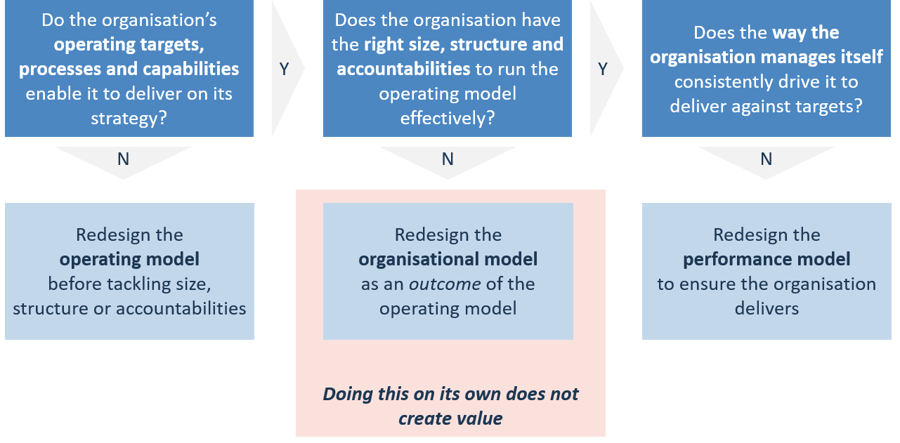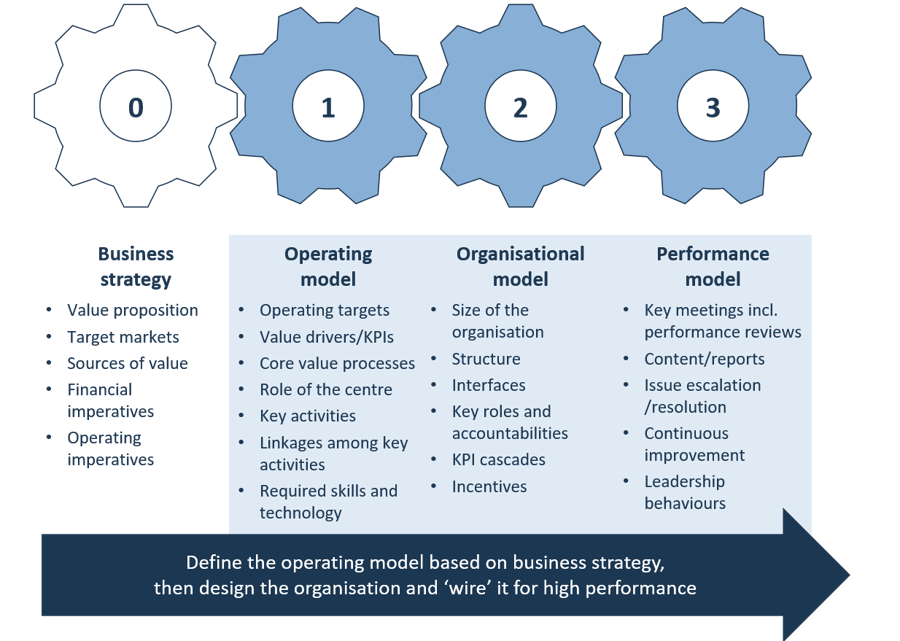Restructuring can be a critical survival strategy for businesses facing tough economic conditions. Done well, it will also help you position for the upswing. However, poor design too often produces a slash-and-burn exercise that compromises the organisation’s future growth. It can also result in leadership “deck chair reshuffling” that creates the illusion of change rather than any real improvement in performance.
In our experience, there are three critical factors underpinning effective organisational redesign – click below to jump to each section:
When to reorganise (and when not to)
Leaders often look to organisation redesign as a way to achieve greater operational efficiency or effectiveness – usually based on the heartfelt belief that greater control over critical functions or decisions will produce better performance.
The trap is that modifying team sizes and reporting structures rarely delivers sustainable value on its own, because there has been no fundamental change in how the business operates. If the underlying operating model doesn’t change, the organisation will continue to create or destroy value much as it did prior to the restructure. At the same time, restructuring inherently increases the risk of employees feeling disenfranchised. Even the best implementations can leave people feeling their jobs are less secure or their accountabilities less clear.
It is therefore critical to be confident that the long-term value delivered via restructuring is worth the disruption. The first question to ask is, ‘what problem are we solving?’ We have found that leaders often reach too quickly for reorganisation as an improvement lever; instead, we advocate significant structural change only if it’s required to run a substantially changed operating model.
Material operating model changes are most often driven by a shift in strategy. Significant change in the markets in which the organisation operates, adjustments to product or service portfolios, or shifts in how the organisation generates value require new operating capabilities that the ‘old way of working’ is very unlikely to offer: they necessitate major changes to what the organisation needs to be good at, and what good looks like.
Conversely, when the operating model is largely unchanged, we have found it is far more effective to strengthen the management disciplines that drive performance, than to tinker with the structure.
Identifying the root cause of performance challenges is key:

How to reorganise so that it drives real operational improvements
There are many ‘bear traps’ in organisation redesign. Without a direct and concrete link to strategy, the risk of under- or over-valuing existing capabilities, systems and assets is high, and it can be tempting to simplify the effort by force-fitting a single design template (e.g., functional, product-led, geographic, customer segment-based) across the structure.
To avoid these traps, it is critical to develop three interlocking models, firmly connected to strategy:

1. Optimise the operating model
The operating model is the critical connection that translates strategy into the day-to-day reality of how the organisation must run in order to execute that strategy. In the face of significant market shifts, an updated operating model will often need to enable step-change improvements like ‘deliver current outputs at half the cost’ or ‘reduce response times by 75%’. It is important to crystallise strategic targets like these into hard operating targets, which in turn drive the design of the new model. Meeting these targets will often require significant, targeted change to processes and capabilities: increases in automation and digitisation, major new business partnerships, shifts in outsourcing or offshoring, or building new technical capabilities.
The new operating model therefore defines the processes and core capabilities required to deliver on the strategy, along with the key performance indicators (KPIs) to track. Crucially, working from the end-to-end view of how the organisation creates value, it also highlights the key decisions required. This then narrows the options for the structure design. For example, if a telco’s strategy depends on frequent launch of new products, it’s critical to define what processes will co-ordinate inputs from functional experts across marketing, engineering, finance, product design and channels, and what roles each should play in key decisions. Once these elements are clear, developing the organisation structure becomes a less political and more strategic exercise.
2. Build the organisation to deliver
The right operating model therefore sets the stage for organisation design. Because functional roles in delivering value are clear from the start, the focus in the detailed organisation design is to align the size of the organisation to its role in value delivery, and then to build in as much ‘single-point accountability’ as possible. This gives divisions and individuals clarity on what they are responsible for, which in turns both accelerates decision-making, and improves its effectiveness.
This also means developing pragmatic solutions that optimise for critical capabilities: it is often sensible to modify the theoretically “correct” structure to reflect market dynamics such as skills shortages, or internal realities such as the need to retain institutional knowledge. The process needs to be sufficiently iterative for leaders to be confident they have got the right teams in place to deliver: the right resourcing, the right accountabilities and reporting lines, and the right names in boxes.
3. Drive high performance that lasts
To deliver on its potential, the organisation will need to adapt its old performance management systems. The new performance model must reflect new targets and accountabilities, reinforcing the new capabilities and embedding the new behaviours required to make the operating model run well.
Too often we see leaders under-invest in this final piece of the puzzle: once the disruption of the restructure has passed, it can be tempting not to invest in detailed change to the management operating system. However, the ‘organisational drumbeat’ of the organisation is what ultimately drives performance – carefully designed governance, interdepartmental and departmental meetings embed new accountabilities, address performance issues, and accelerate major operating decisions.
This is also the opportunity to embed continuous improvement into how you run your organisation. By engaging leaders in setting stretch targets, and beginning to generate a pipeline of improvement ideas, continuous improvement disciplines set the stage for ongoing gains in efficiency and effectiveness – significantly reducing the risk that the organisation will need to endure the same disruptive exercise again.
How to implement for lasting impact
Making change across core elements of how the organisation operates, what roles its people play, and how it manages performance requires careful co-ordination and phasing. When there is significant time pressure, especially when market conditions have changed rapidly, it takes enormous discipline to achieve long-term high performance: it means rapidly separating the critical changes and interdependencies from the optional, and then maintaining the laser focus to drive at the right pace, while bringing your team on the journey.
We have found that those prioritised changes are best owned by individual line leaders, each detailed to a level that enables weekly progress tracking and effective risk management. A detailed transition plan that integrates across these individually specified plans is then key to catching resource conflicts and other barriers.
How well you engage your people on why the change is required, what benefits it will deliver, and how it will affect employees and other stakeholders can make or break the programme. It’s critical that senior leaders are consistently visible in leading the change, using a wide variety of media, from newsletters to town hall meetings to social media groups, to share progress and address concerns. Reporting progress publicly to the entire organisation reminds employees of why the change is required, and keeps the leadership team honest on progress vs. objectives.
With so many moving parts, a lean ‘Transformation Management Office’ (TMO) can be a sound investment. A small but highly capable TMO is far more valuable than a large one, in our experience: larger TMOs invariably remove some accountability from line management and, for the transition to be sustainable, it’s imperative that line managers own the change all the way through to achieving their new targets.
The role of senior management
Critically, the new operating model, organisation and performance management systems will only be successful if senior leaders visibly champion the change. This leadership is essential in setting the aspiration, running the design process, and then in spearheading implementation. Done properly, this will take up significant time, but it is vital and cannot be outsourced to external consultants or middle management.
Conclusion
In a changing market, restructuring can be a useful tool to improve performance – but only if the operating and performance models are equally well designed. Leaders need to be very clear on why redesign is required, and how it will help to achieve operational objectives, and then actively reinforce the new, improved ways of working. A new organisation structure is never an end in itself.
We frequently support leaders to shift their organisations to a new way of working – from optimising the new operating model through to embedding the new organisation and performance model into the organisation’s ‘DNA’. Our approach is always to coach line managers in leading the change, empowering them to create lasting impact in their organisations.
Click here for more information on our organisational work. Alternatively, please feel free to contact us with any queries.
About the author

Tom Schnitker
Tom is the Managing Director of our South East Asian region and heads our Organisation Practice globally. He has over 30 years’ experience in consulting and executive line management in diverse environments across South East Asia, Australia, New Zealand, Africa, Europe and Latin America.

